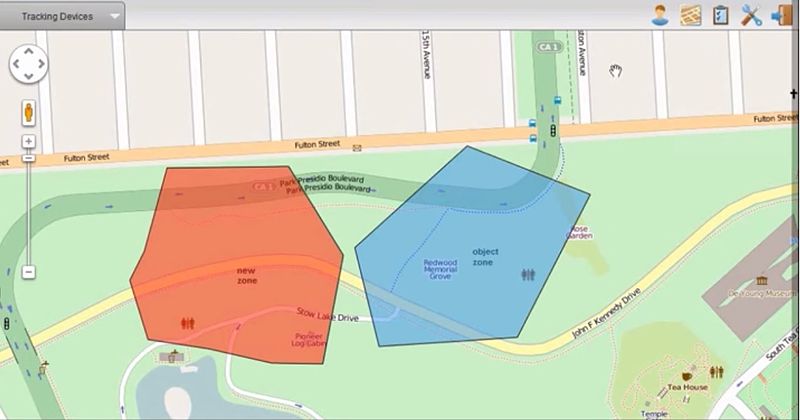Geofencing’s concept originated from applications tied to the US Navy’s use of the Global Positioning System (GPS) starting in the 1960s. Today, geofencing is used to drive many features and applications. A familiar example, proximity marketing, generates SMS messages based on a mobile user’s location to promote sales. That’s just the most visible example, as many more uses are becoming increasingly commonplace. To get a better grip on this technology and how your business can put it to use, we’ll examine what geofencing is, and how it works with mobile applications and devices.
What Is Geofencing and How Does It Work?
Geofences are virtual geographic boundaries that enable software and applications to trigger a response when mobile devices enter or leave a particular area. Geofencing apps can work with GPS, RFID, Wi-Fi, and cellular networks. The functionality is provided by software or mobile applications, so no hardware is involved beyond that embedded in location-aware devices — GPS microchips, for example.

Two geo-fence zones defined in Golden Gate Park, San Francisco, California, USA, by a Global Positioning System application – picture from WikiMedia Commons courtesy of SpyToMobile.Com.
The geofence for an area can be as simple as a radius around a fixed point, or one created by applications that make use of mapping systems like Google Earth to define boundaries of any sort. In proximity marketing, geofencing apps can be used to target people not just by city, zip code or neighborhood, but by specific buildings they enter.
What Can Geofencing Apps Do?
Starting with the obvious, retailers can send an SMS to customers when they enter the proximity of a store. Equally, geofencing apps can notify parents of children, elderly caretakers, and pet owners, if their wards leave a designated area. In the public services arena, emergency services can use geofencing to draw a perimeter around a hazardous location to warn people and vehicles to find an alternate route. Some of today’s top headhunters use geofencing to reach preferred candidates based on locations they are likely to visit. You can even target people doing business with your competition!
Mobile geofencing apps are by no means limited to sending SMS messages, though – they can be put to a wide and varied set of uses:
- On-Demand and Delivery Services: Automatically assign orders to an area’s designated service provider.
- On-Demand Services: Can assign orders dynamically to service providers based on their location at any given time. In this case, the “virtual fence” is a radius around the service provider’s vehicle and not a fixed boundary.
- On-Demand Transportation: Track Electronic Transportation Devices like electronic bikes or scooters and their distance from charging stations.
- Transportation Management: Track the flow of people using public transport systems or its integration with ride-sharing applications and autonomous vehicles.
- Commercial Real Estate: Identify how many people drive or walk by a specific location.
- Retail Shopper Guidance: Guide a customer to a specific product once they are in your store.
- Network Security: Geofence security for wireless local area networks (LAN) for use with designated users and devices.
- Property Security: Open or lock doors as individuals with designated devices approach or leave a building or vehicle.
- Property Control: Can restrict vehicles to be operational only inside a geofenced area – like drones or construction equipment that must be left on the work site. Similarly, a weapon shop can restrict firearm usage to its firing range.
- Human Resources: Used to monitor employees engaged in off-site work and to track transit times between locations.
Real-Time Geofencing Visualization and Management
Another component of an effective geofencing application is the User Interface and Display. The User Interface (UI) is critical to making it as easy as possible for administrators to use, and especially to add new geofences, in real-time. New geofences might involve adding new service providers, dedicated service areas for specific service providers, or out-of-bounds areas where autonomous vehicles and drones should not go.
The display shows all of your geofences, which can be useful to managers to increase or decrease geofencing parameters based upon traffic load. In an Uber-like On-Demand service, for example, being able to adjust the availability of all service providers can be critical during peak usage. Should service providers respond to calls in a 1-mile or 5-mile radius? Are there location-based sporting or concert events warranting a message to select service providers informing them of opportunities in that part of the city?
A real-time geofencing visualization and management system provides you with the kind of bird’s eye “zoom-in and zoom-out” capabilities you need to manage any kind of situation.
As the Bird Flies… or Not?
It’s nice to be able to see things from a bird’s eye perspective, but the shortest distance between two points is different if you’re going by car or by drone. Our client, Q.care, a Texas-based Healthcare On-Demand service, made it possible for parents with sick children to arrange for housecalls by a pediatric nurse practitioners. If you’ve been to Texas, you know that some areas are very sparsely populated… and have even fewer roads.
Service providers (i.e., the nurse practitioners) included those affiliated with participating hospitals and independent practitioners. We used zip code geofencing to define the area of operation for each participating hospital. Additionally, a radius-based geofence was created for each nurse practitioner to define which was most suitable to visit a patient. For actual travel time, we integrated routing APIs to optimize the algorithm and calculate a true estimated time of arrival.
Putting Geofencing Apps to Use for Your Business
How can you use geofencing in a way that would be profitable for your business? It will need to either automate a time-consuming activity, help create new customers, generate valuable business data, help secure property, or prevent costly mishaps. As we’ve addressed at length, mobile apps involve a significant investment requiring thought about the return on your investment. For most On-Demand businesses, geofencing is an intrinsic part of the entire business model.
We’ve addressed many of these considerations in Cashing in with Mobile Wallets and Customer Loyalty Programs. Geofencing can work very well with both of those applications, not just with proximity notifications, but providing in-store guidance to help customers find products on their shopping list, along with hour-by-hour and aisle-by-aisle heat maps.
Freakin’ Amazon… Again?
If, as a retailer, you are concerned about competing with Walmart — you have good reason to be. Walmart is itself concerned about Amazon, and if you can’t beat Walmart on cost, convenience or sheer goodwill of your local community, the technologies of tomorrow may be very scary. Bloomberg recently noted that Amazon may have plans to open up to 3,000 Amazon Go cashierless convenience stores by 2021 — and has intentions to do the same with larger stores, too.
There’s no reason to panic, yet. But project what Amazon is doing now over the next ten or twenty years. If in 1998 anyone said that Amazon would capture 50% of all US online spending ever, they’d have been laughed out of the room. Just two years ago financial experts and newscasters were always quick to point out that Amazon only generated 2% of all retail spending. That’s up to 5% now — and it tells me that perhaps we should have a discussion on Lanchester’s Laws. (/end rant)
Amazon Go makes use of Mobile Wallets, Customer Loyalty Programs, Geofencing, Facial Recognition, and a lot more. Fortunately, for now, it’s still limited to one store in Seattle. Regular readers know that we watch and comment upon Amazon.com’s activity on a fairly regular basis because of its focus on technology, omnichannel marketing and how well it is putting everything to use.
Where Are You with Geofencing?
What kind of geofencing applications have you been considering for your business? It’s likely that you’ve used it in proximity marketing as that’s been the most popular geofencing application for several years. Only around 2016 did the tech world start to explore creative options for it. Maybe you have some new ideas of your own or thought of more while browsing our list of examples. Swiftmile, another one of our clients making use of geofencing recently came in as the 3rd place winner out of 1,400 entries from 78 countries in Verizon’s Powerful Answers Global Award.
If you have an idea for a geofencing app, we’d love to hear from you about any questions you may have or perhaps arrange a workshop to define exactly what you’ll need to make it work!



 (3 votes, average: 4.33 out of 5)
(3 votes, average: 4.33 out of 5)


Leave a Reply